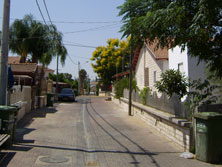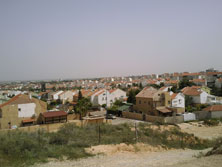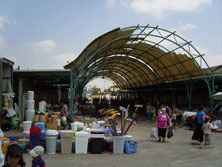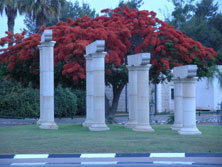
Sderot has a reputation, she has a name that most people relate to being the bomb shelter capital of the world and the only city in Israel that has endured 12 years of Kassam rocket attacks from terrorists in Gaze, but she is more than that.
David Farer not only a freelance writer and author but is also a part of the Hope For Sderot family. With his permission I am pleased to present you with “A BRIEF HISTORY OF SDEROT”

HISTORY OF SDEROT
By David Farer
INTRODUCTION
The origin and development of Sderot is in many ways the history of the growth of Israel . A look at how this town developed gives an understanding not only of the development of a small town in the Negev, but of Israel itself.
The Negev had almost no Jewish population before Israel became an independent state in 1948, and indeed little Arab population, either. A few kibbutzim existed near what became the ceasefire lines defining the new entity that came to be known as the Gaza Strip.
Pressure of Jewish immigration that the British Empire wanted to prevent caused Israel to seek independence, and this pressure ultimately broke British power over the country. These immigrants were mostly Holocaust survivors languishing in European refugee camps, many of which had been Nazi concentration camps a short time earlier.
That wave of immigration was the first come to Israel during the War for Independence and immediately afterwards. Other waves followed. It would have been more convenient had it been possible to bring them to Israel in an orderly way, but the timing of their arrival was largely a factor of political circumstances in the countries of their birth, available transportation, and the political accidents of those crazy times.
Some Arab leaders wanted to send all their Jews to Israel , partly in order to get rid of a Jewish population they despised, but also on the theory that the sudden arrival of hundreds of thousands of new immigrants would cause Israel to collapse economically and socially. Those first years after Israel’s independence were very hard – recovering from the damage Israel had suffered during the War for Independence, when one per cent of the country’s tiny population of six hundred thousand had died in combat, but the country made it, if with enormous difficulty, largely because of its own will to live.
Absorbing immigrants meant not only bringing new people, most of whom spoke no Hebrew, many of whom came from backgrounds of persecution, or who had been born in countries where there had been little opportunity for education and training. Israel was also building itself: new towns, new farms, and new cities – everything had to be created out of nothing but brains, muscle, and will.
The immigrants had to learn Hebrew in order to get jobs and to communicate with immigrants from other countries. They needed skills in order to work. The state had to support them and give them housing and food until they could do these things for themselves. Six hundred thousand Jews became the first Israelis on Israel’s first Independence Day, but this population had climbed to two million within ten years – that is to say that Israel’s population had tripled in one decade.
The history of Israel is the history of these waves of immigration. Israel, like the United States, Canada, Australia, and a few other countries, is a country of immigration. It is impossible to understand how those societies work without reference to that historic fact.
FOUNDING SDEROT – the 1950’s
 The history of Sderot is also the history of those waves of immigration. The first people to live in what was to become Sderot were brought here in trucks from immigrant ships arriving at Haifa port. About eighty families came to the maabarot, which is Hebrew for “transition camp”. The idea was for people to live in these transition camps until permanent facilities were built. During the early ‘fifties, as many as a quarter of a million new immigrants lived in maabarot at one time. This total came to more than a tenth of Israel’s population.
The history of Sderot is also the history of those waves of immigration. The first people to live in what was to become Sderot were brought here in trucks from immigrant ships arriving at Haifa port. About eighty families came to the maabarot, which is Hebrew for “transition camp”. The idea was for people to live in these transition camps until permanent facilities were built. During the early ‘fifties, as many as a quarter of a million new immigrants lived in maabarot at one time. This total came to more than a tenth of Israel’s population.
These first eighty Sderot families came from Kurdistan in northern Iraq, and from Iran. They lived in tents – the bigger families had an entire tent for themselves, but smaller families had to double up and share space with other families. There was neither water nor electricity at the little camp called Gibbim-Dorot. The people worked for the neighboring kibbutzim; the government thought that putting these people near kibbutzim would supply the kibbutzim with labor, and the new immigrants with jobs.
As more and more immigrants were brought to the camp, the tents gave way to “pachonim”, tin can houses with a couple of windows and a door poked through the metal. They were devastatingly hot in summer, but their inhabitants froze from the winter’s cold – very bad, but better than the tents. The pachonim were what Israel had to give at the time.
The people who lived in them did the logical thing to improve their conditions: they demonstrated, marched, and demanded better conditions, at one time even blocking the road to their camp. To the pachonim were soon added shacks for two families, with each family having half a shack. Because of pressure from below, the steadily improving Israeli economy, and the sincere intention of the government to build those places up, things were progressing. The line was from tents, to tin cans, to shacks – gradual but genuine improvement.
The social changes this life brought about were not less significant than the geographical change of moving to Israel . Soldiers knocked on the “door” of a woman arriving from a village in the Atlas Mountains in Morocco to volunteer to teach her Hebrew. This new skill gave her not only the new language, but it made her literate for the first time in her life, for she had not previously learned to read and write in any language.
She became employable. She also discovered a marvelous new invention: the icebox. For the first time in her life, she could prepare food a few days before it was to be eaten. This woman was not only employable, but she was no longer tied to her kitchen all day. She learned a new role in society, and her husband had to get used to it.
Several women of that generation told me how liberated they felt to live in tin can houses in Israel, even if they had enjoyed a higher standard of living back in Morocco.
By 1955, the time had come for permanent buildings. These were all built by Israel’s socialist government, which was deeply involved in every aspect of populating the Negev and building the country.
In one dramatic incident that stays in the memories of those who were there, a crowd of several hundred people descended from the tents and the tin-cans upon these new houses, seizing and entering them before they had doors and windows, and in some instances, even roofs. Nobody was planning to send in the police to chase these eager people out until their houses were officially ready. The government did things fairly effectively, but the pressure from below encouraged the bureaucrats to work harder.
These new houses counted twenty-eight square meters. They had a rather large patch of ground around them. An advantage Sderot offered then, as today, is that real estate is not expensive; if people cannot have luxury, at least they get space. The intention of these green patches was for people to supplement their incomes by growing, eating, and selling vegetables. Most of those kitchen gardens have become family back- and front yards now.
People moved community by community to their new neighborhoods and their new homes, with the Kurds and the Iranian Jews living in different streets of their tiny new village. By the end of 1956, the maabarah was gone. Only a few tin can houses remained. A couple of families preferred to remain in them in order not to pay municipal taxes. Some pachonim were moved or recycled as parts of new homes. Most became scrap metal.
These years brought many basic changes to life in Sderot. The government-appointed committee that had administered its public affairs was replaced by a popularly elected municipal body. People had local elections, and therefore parties and politics. They learned to attend meetings, express their opinions, and fight things out until they compromised; such rough democracy had not existed back in the Kingdom of Morocco.
Electricity arrived; and right behind it came electric refrigerators. The iceman who delivered ice to everybody’s tin can home sold his donkey and went to work in one of the new factories that began to spring up in the town’s industrial zone. Factory work became his third career.
Back in Morocco, he had made daggers to sell to the Arabs in the village where he had been born. The family who had made the ice he sold after he came to Sderot, where nobody needed his daggers, rebuilt their ice-making freezers to make ice-cream – a luxury few people could have afforded only a few years earlier.
The first schools opened in 1957. The area began to take on its present garden-like appearance as the government hired many residents to plant trees and bushes around the town and along its three streets. The first row of shops opened in 1958.
In 1955, the local town council asked the government in Jerusalem to give a name to this new part of the Gibbim-Dorot refugee camp. The government office in charge of place-names picked one that is mentioned the first Book of Kings, in chapter six in connection with this general part of the Negev . The little town would be called Sderot.
CONTINUING BUT GRADUAL PROGRESS – the 1960’s

The following year was the year of the Moroccans. Political instability in Morocco, caused partly by the radicalism of the war across the border in Algeria, brought thousands of Jews from Morocco to Israel. By the end of 1962, Moroccan Jews had become the majority in Sderot.
New neighborhoods had to be built to accommodate all these new Israelis. They moved into the first apartment blocks, or shikunim, of Sderot. Their neighborhoods were Nir Am, extending west from the center of town, and more free-standing homes on the village’s western edge.
The process of immigrant absorption had changed: no more tents and no more tin cans. The new slogan was “From the ship to the home”. These new immigrants received “tlushim”, or tickets entitling them to buy things; the first tent-dwellers in the old Maabarah had been fed directly from soup-kitchens set up in their camp. The immigrants of the ‘sixties chose what they wanted at local shops that had not existed a few years earlier.
SDEROT COMES OF AGE – the 1970’s

The next big change for Sderot came with the election of Meacham Begin as Israeli Prime Minister in 1976. The following years, Israel’s Begin years coincided with the rise of the first generation of young adults who had been either born in Sderot or brought here too young to remember much about their countries of origin. They were “Sabras” – part of Israeli society, knowing Israeli culture, and determined to exercise political and economic power. They served in the army; they had Israeli educations.
These interlocking phenomena brought many changes to Israel in general, but particularly to Sderot. The young people were not willing to react passively to a socialist government that decided what was good for them. The Moroccan and other Middle-Eastern immigrants had never been big socialists anyway; that tradition was confined to the Jews from Eastern Europe.
While the Sfardim should and do feel proud of building and living in Sderot, many Jews of oriental origin felt condescended to by the ruling European-born, kibbutz-oriented establishment. Some of the older generation thinks that, when they went to the government education offices after completing military service, they were automatically sent to non-academic courses. The Moroccan youths who had been raised and educated in Israel, and who had served in its army, demanded their turn to get ahead. Having been through the Israeli school system, they intended to proceed to the university system as well, to get good jobs, and to join the middle class.
Premier Menachem Begin agreed. The oriental Jews had voted heavily for the Likud and the Israeli right. Begin and his new government made many changes in the daily life of Sderot. Money for beautifying the city with more parks appeared, and business investment was directed to the city. Schools had more budget to spend. The local college, Sapir, expanded enormously in the numbers and the quality of its courses. Israeli education became more inclusive.
Many older Sderot residents look back on the 1980’s as a kind of golden age for their town. Things were looking up for them, economically, educationally, and culturally. Peace prevailed. It was common for people drive or take a bus over to Gaza to shop in that town’s market, even as many Arabs from the Gaza Strip shopped or worked in Sderot. It was the last period of “intimate Sderot”, when everybody knew everybody else. The people could point with pride to the good life they led together, and to the dramatic progress they had made since the days when they lad lived in tin cans and were glad to have even them.
DOUBLING SDEROT’S POPULATION – the 1990’s

Their arrival added entire new neighborhoods to Sderot. The population doubled, but the town’s area more than doubled. Additional buildings had to be built onto schools. Sderot became legally a city, which changed the way it was governed. Several new factories opened in the industrial zone. Most people in Sderot associate the decision to bring the new immigrants with David Bouskila, Sderot’s mayor at the time.
Most of these new immigrants came from Dagestan. Dagestan is an autonomous republic within the Russian Federation . Dagestan did not become an independent state when the Soviet Union broke up, because it was theoretically part of Russia . Dagestan is on the northern slope of the Caucasus Mountains . About thirty tribes live there, each with its own language and traditions, and one of these tribes is the Jewish tribe. Only a century and a half ago, the Caucasus Jews, like everybody else in Dagestan, lived as nomads, roaming over the mountain trails of the Caucasus peaks and fighting with the other tribes. Few Jews came to Sderot from European Russia.
A smaller number of immigrants came from Ethiopia . The Ethiopian Jews came suddenly, so that a complete, new neighborhood was prepared for them very quickly on the northern part of Sderot. Many of these families tell of having been smuggled out of Ethiopia through the desert in Sudan, starvation back in Ethiopia, and finally coming home to Israel . Here they had to get used not only to the new country, but also to modernity itself.
CONTEMPORARY SDEROT: the Kassam challenge

The millennium dawned brightly for Sderot, but times rapidly darkened. The Arabs of Gaza began firing Kassam rockets at the little town in 2001. These terror attacks against civilians accompanied the terrorist wave of suicide-bombings known as the Second Intifada. They were in fact an aspect of that Islamist terror offensive against Israel’s civilians. Sderot rapidly became known as the place that is bombed every day. Among the early casualties were a pair of Ethiopian children, killed by a rocket just a few years after their parents had with such suffering and determination made it to Israel and to Sderot.
These daily rocket assaults damaged Sderot in many ways. Apart from the general nervousness and human misery the Arabs caused, the rockets greatly lowered the level of productivity people would otherwise have enjoyed. Students could not study, and workers could not work. If a rocket fell in town at night, everybody woke up; most people did not return to sleep, and therefore did little the next day.
The Kassams hurt Sderot’s economy. A number of factories that had been operating well and profitably had to close, because they were unable to continue working under such conditions. If a rocket fell somewhere in town, the employees unanimously pulled out their cell-phones to call their friends and relatives to reassure them and to be reassured by them. One rocket could take an hour away from a work-shift. The managers can hardly order people back to work, if they themselves had been just as shocked.
Restaurants and shops also suffered, and a number had to close. People went shopping only when they had to, and they stayed home in the evenings. When a Kassam exploded in an open area, it shot shrapnel hundreds of feet in every direction; taking a short-cut across a park therefore became risky. Children going out to play with their friends caused parents to panic. Sderot is a very walkable place, with many open green spaces and parks. People were less inclined to go out and enjoy their pleasant little town as they had once done. Joggers, for example, disappeared.
Some of the substantial progress Sderot made during the decades preceding the Kassam period was reversed. Many people left for other parts of Israel. Those leaving were those most skilled. When a business closed in Sderot, trained people had to find new jobs. The trained and the experienced had more options; many less educated people would have liked to leave as well, but they could not. Who knows what opportunities the town lost, because people and institutions that would have moved here did not?
Sderot suffered, and continues to suffer from a high percentage of Post-Traumatic Stress Disorder (PTSD). The percentage of residents who have hearing problems also seems high, because a Kassam detonating even a few blocks away makes an hellacious blast that can be literally deafening. One often hears of bed-wetting children. An old man crossing a park about a hundred feet ahead of me began vomiting when we heard the alarm. He continued walking, vomiting as he went, until we heard the explosion some distance away. The elderly man then stopped vomiting. He suffered no physical wound from the Kassam, but I am sure it did his psychology no good, and people have been known to have heart-attacks when a Kassam hits, even at some distance. The pioneers who lived in the tin cans, served in the army, and built the town up from nothing are angry, because their children are afraid to bring their grandchildren to visit them. They worked hard to create their lives in Sderot, but today they cannot enjoy what they built.

The people of Sderot have enjoyed the support, both emotional and practical, of many donors and volunteers. Prominent among the donors have been the International Fellowship of Christians and Jews, who built most of the shelters that sit next to the bus stops of Sderot. Volunteers have come to help the town from all over the world. They include Europeans, a Chinese woman, Americans both black and white, and people of good will from many religions.
While the bad times are not over, the days when we assumed that several Kassams would explode in the middle of Sderot every day seem to have passed. The Israeli military operation, Cast Lead, caused the Islamists over the border to think twice before bombing Sderot constantly, although they continue to fire the occasional rocket at us, and these rockets continue to hurt and damage people. During the most recent fighting, in March of 2012, Israel’s armed forces deployed the defensive system Iron Dome for the first time. This anti-missile system, combined with the deterrence Israel has established against Hamas, will hopefully keep the violence down to manageable levels. As Egypt turns increasingly to radical Islam, its border might well return to or exceed the violence of several years ago.
During the present period of relative calm – frequently interrupted by Islamist rockets, don’t forget – has allowed the ever-resourceful and optimistic people of Sderot to rebuild themselves and their town. New homes are being built, new businesses are opening, and people take walks again. The prosperous Israeli economy is rising; Sderot demonstrates that a rising tide floats all boats. A major international company like Amdocs has seen fit to open a branch in this town, almost on the exact spot where the first tents were built sixty years ago. Computer software is now designed where the first immigrants lived in canvas software.
A major reason why the people of Sderot made it through the hard years is exactly that history that they, their parents, and their grandparents shared. I have seen the town’s mayor, David Buskila, drive directly to people’s homes just after a rocket hit the building. His parents knew the parents of those whom he hugged and comforted. This kind of solidarity strengthened the people of Sderot during periods when they needed all the emotional strength they could get.